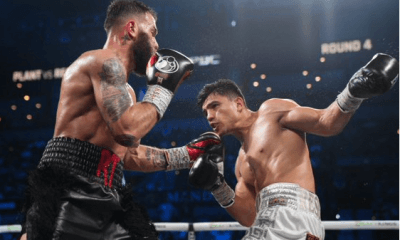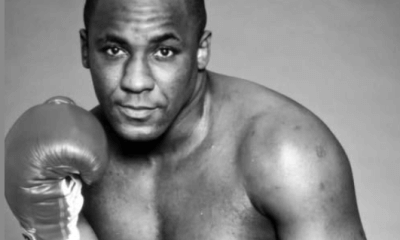Featured Articles
L.A. Sports Arena Welcomes Khan-Molina Fight
 LOS ANGELES-Prizefighting in Los Angeles has very few historic venues remaining that have not been torn down or transformed into a church, parking lot or bowling alley. It's a shame.
LOS ANGELES-Prizefighting in Los Angeles has very few historic venues remaining that have not been torn down or transformed into a church, parking lot or bowling alley. It's a shame.
But on a bright Tuesday afternoon, Golden Boy Promotions held a press conference at the 53-year-old L.A. Sports Arena where a major boxing event baptized the building that is located across the walkway from the Los Angeles Coliseum. Now here comes another.
Former world champion Amir “King” Khan (26-3, 18 KOs) returns to the ring wars and faces Los Angeles-bred Carlos Molina (17-0-1, 7 KOs) on Saturday Dec. 15 at the Sports Arena. The Golden Boy Promotions fight card will be televised on Showtime.
Not since 1996 has a major fight card taken place at the old Sports Arena where some of the greats like Muhammad Ali, Sugar Ray Robinson, Ruben Olivares and many others traded blows in the arena located along Figueroa Street.
“This building has quite a history with boxing,” said Jonathan Lee, general manager of the Sports Arena. “We're very happy Golden Boy decided to bring this event to us.”
Back in 1959, Mexico's Jose Becerra defeated Alphonse Halimi to win the bantamweight world title amid delirious boxing fans in the very first major boxing card.
“The building wasn't even completed yet,” said Bill Caplan, the dean of boxing public relations who attended uncountable events at the arena included the Becerra-Halimi bout. “I was here everyday during the 1984 Olympics. It was a great year for Los Angeles.”
With new venues springing up all of the time in the Los Angeles area, the Sports Arena has been largely passed over.
Khan is not ready to be passed over when it comes to junior welterweights. Neither is Molina, who fought numerous times in the L.A. area and has built up fan support over the years as an amateur and now as a pro.
Both arrived with their trainers and teams to face the crowded media throng.
“This is a comeback fight for us,” said Khan, whose last bout ended in a knockout loss to current WBC junior welterweight king Danny “Swift” Garcia this past July. “People want to see what I've got left.”
Accompanying Khan was new trainer Virgil Hunter, from the San Francisco Bay area, who replaces Freddie Roach.
“We've made some assessments,” said Hunter, who also trains Andre Ward, Alfredo Angulo and Karim Mayfield among others. “Amir is a good listener.”
For the past four weeks Khan has been in the Bay Area sparring and training alongside Angulo and the others. It's been a contrast from his former Hollywood training quarters.
“It's much more quiet,” said Khan.
The British speedster said the private setting has allowed him to escape the media scrutiny of the British press that has harangued him recently for alleged personal relationship indiscretions.
“My fiancee doesn't believe these words they're saying about me in the press,” says Khan. “We talk everyday.”
There won't be much talk between Molina and Khan.
“This is a dream come true,” said Molina, who is originally from Norwalk, a small city located 20 miles southeast of the L.A. city limits. “I want to thank Amir Khan for taking this fight, but he made a big mistake.”
Molina says he's been waiting for this big fight his entire boxing career, including amateurs.
“It couldn't be any better than in front of my hometown,” Molina says.
Oscar De La Hoya, who lived and fought in the Los Angeles area his entire career, knows the significance of both the fight and the venue.
“Muhammad Ali fought here three times in one year,” said De La Hoya, the president of Golden Boy Promotions. “We're all just extremely excited that boxing is back in L.A.”
Showtime's Stephan Espinoza said the network has enjoyed incredible success this year and is confident it will continue with this pending fight.
“It will cap off one of the most eventful runs in Showtime history,” Espinoza said.
Khan and Molina are in agreement.
“I'm getting ready for an all out war,” Molina says.
-

 Featured Articles4 weeks ago
Featured Articles4 weeks agoA Night of Mismatches Turns Topsy-Turvy at Mandalay Bay; Resendiz Shocks Plant
-

 Featured Articles2 weeks ago
Featured Articles2 weeks agoAvila Perspective, Chap. 330: Matchroom in New York plus the Latest on Canelo-Crawford
-

 Featured Articles1 week ago
Featured Articles1 week agoVito Mielnicki Jr Whitewashes Kamil Gardzielik Before the Home Folks in Newark
-

 Featured Articles4 weeks ago
Featured Articles4 weeks agoRemembering the Under-Appreciated “Body Snatcher” Mike McCallum, a Consummate Pro
-

 Featured Articles4 weeks ago
Featured Articles4 weeks agoAvila Perspective, Chap 329: Pacquiao is Back, Fabio in England and More
-

 Featured Articles3 weeks ago
Featured Articles3 weeks agoOpetaia and Nakatani Crush Overmatched Foes, Capping Off a Wild Boxing Weekend
-

 Featured Articles3 weeks ago
Featured Articles3 weeks agoFabio Wardley Comes from Behind to KO Justis Huni
-

 Featured Articles2 weeks ago
Featured Articles2 weeks agoCatching Up with Clay Moyle Who Talks About His Massive Collection of Boxing Books
















